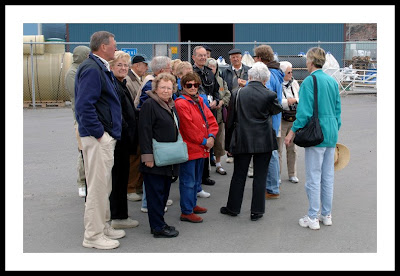




 MIDDAY IN HAMMERFEST at 70º 39’ 48”, puts it at roughly the same degree of latitude as Point Barrow, the northernmost part of Alaska. The Gulf Stream brings warmer water and warmer air to this region, so it isn’t as cold as the islands north of Canada and the center of Greenland... but it’s cold enough in winter. We are enjoying a summer day here with temperatures in the mid-fifties. For several days we have stopped at fishing villages with the small clusters of red, blue, yellow, white and green houses; Hammerfest has the feel of a town, almost a city, with taller buildings. There are no skyscrapers, but several structures have the mass of city buildings. Hammerfest was a natural base for German operations in the North Atlantic between 1940 and 1944. When the Germans left, they leveled the town, so what we see today was built since World War II. The entire end wall of Hammerfest Church is a spectacular stained glass window. The crypt is the only building in the town to have survived the war. There is a bustle here that is completely absent from the fishing villages. In 1891, Hammerfest became the first town in Norway to have street lighting. Today turbines have been installed in the seabed to generate electricity from the tide-run.
MIDDAY IN HAMMERFEST at 70º 39’ 48”, puts it at roughly the same degree of latitude as Point Barrow, the northernmost part of Alaska. The Gulf Stream brings warmer water and warmer air to this region, so it isn’t as cold as the islands north of Canada and the center of Greenland... but it’s cold enough in winter. We are enjoying a summer day here with temperatures in the mid-fifties. For several days we have stopped at fishing villages with the small clusters of red, blue, yellow, white and green houses; Hammerfest has the feel of a town, almost a city, with taller buildings. There are no skyscrapers, but several structures have the mass of city buildings. Hammerfest was a natural base for German operations in the North Atlantic between 1940 and 1944. When the Germans left, they leveled the town, so what we see today was built since World War II. The entire end wall of Hammerfest Church is a spectacular stained glass window. The crypt is the only building in the town to have survived the war. There is a bustle here that is completely absent from the fishing villages. In 1891, Hammerfest became the first town in Norway to have street lighting. Today turbines have been installed in the seabed to generate electricity from the tide-run. I’d like to be able to tell a tale of a narrow escape from the polar bear on an ice flow, but you’d know it would be true; so I may as well say up front that the bear is stuffed in an exhibit center in the International Polar Bear Club in Hammerfest, which I declined to join.


















































